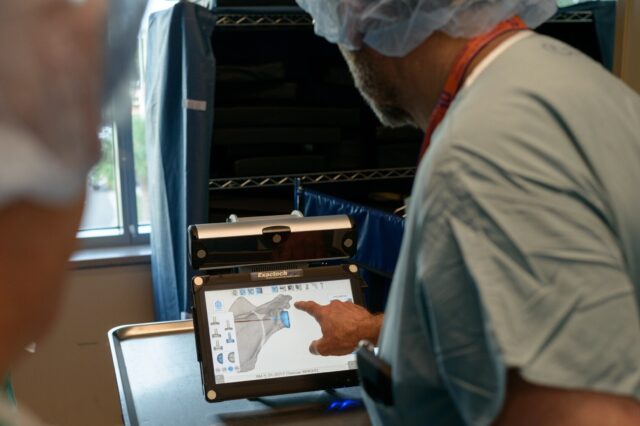Definition
Shoulder replacement is surgery to replace the bones of the shoulder joint with artificial joint parts.
Alternative Names
Total shoulder arthroplasty; Endoprosthetic shoulder replacement; Partial shoulder replacement; Partial shoulder arthroplasty; Replacement - shoulder; Arthroplasty - shoulder
Description
You will receive anesthesia before this surgery. Two types of anesthesia can be used:
- General anesthesia, which means you will be unconscious and unable to feel pain.
- Regional anesthesia to numb your arm and shoulder area so that you do not feel any pain in this area. If you receive only regional anesthesia, you will also be given medicine to help you relax during the operation.
The shoulder is a ball and socket joint. The round end of the arm bone fits into the opening at the end of the shoulder blade, called the socket. This type of joint allows you to move your arm in most directions.
For total shoulder replacement, the round end of your arm bone will be replaced with an artificial stem that has a rounded metal head (ball). The socket part (glenoid) of your shoulder bone will be replaced with a smooth plastic lining (socket) that will be held in place with special cement. If only 1 of these 2 bones needs to be replaced, the surgery is called a partial shoulder replacement, or a hemiarthroplasty.
Another type of procedure is called reverse total shoulder replacement. In this surgery, the positions of the ball and socket are switched. The round part of the shoulder is removed from the top of the arm, and a metal ball is attached to the shoulder bone. The socket is then attached to the arm bone. The ball ends up on the other side of the shoulder. This surgery can be done when the rotator cuff tendons are severely damaged or there are fractures of the shoulder.
For shoulder joint replacement, your surgeon will make an incision (cut) over your shoulder joint to open up the area. Then your surgeon will:
- Remove the head (top) of your upper arm bone (humerus).
- Place the new metal head and stem into place. It can sometimes be cemented in if the bone quality is poor.
- Smooth the surface of the old socket and cement the new one in place.
- Close your incision with staples or sutures.
- Place a dressing (bandage) over your wound.
Your surgeon may place a tube in this area to drain fluid that may build up in the joint. The drain will be removed when you no longer need it.
This surgery normally takes 1 to 3 hours.
Why the Procedure Is Performed
Shoulder replacement surgery is often done when you have severe pain in the shoulder area, which limits your ability to move your arm. Causes of shoulder pain include:
Your doctor may not recommend this surgery if you have:
- History of infection, which can spread to the replaced joint
- Severe mental health illness
- Unhealthy skin around the shoulder area
- Very weak (rotator cuff) muscles around the shoulder that cannot be fixed during surgery
Risks
Risks of anesthesia and surgery in general are:
Risks of shoulder replacement surgery are:
- Allergic reaction to the artificial joint
- Blood vessel damage during surgery
- Bone break during surgery
- Nerve damage during surgery
- Dislocation of the artificial joint
- Loosening of the implant over time
Before the Procedure
Tell your health care provider what medicines you are taking. This includes medicines, supplements, or herbs you bought without a prescription.
During the 2 weeks before your surgery:
- You may be asked to stop taking blood thinners. These include aspirin, ibuprofen (Advil, Motrin), naproxen (Naprosyn, Aleve), warfarin (Coumadin), dabigatran (Pradaxa), rivaroxaban (Xarelto), apixaban (Eliquis), and clopidogrel (Plavix).
- Ask your surgeon which medicines you should still take on the day of your surgery.
- If you have diabetes, heart disease, or other medical conditions, your surgeon will ask you to see the provider who treats you for these conditions to ensure that they are under control.
- Tell your surgeon if you have been drinking a lot of alcohol, more than 1 or 2 drinks a day.
- If you smoke, try to stop. Ask your provider for help. Smoking can slow wound and bone healing.
- Let your surgeon know right away if you get a cold, flu, fever, herpes breakout, or other illness before your surgery.
On the day of your surgery:
- You will likely be asked not to drink or eat anything for 6 to 12 hours before the procedure.
- Take the medicines your doctor told you to take with a small sip of water.
- Be sure to arrive at the hospital on time.
Outlook (Prognosis)
Shoulder replacement surgery relieves pain and stiffness for most people. You should be able to resume your normal daily activities without much problem. Many people are able to return to sports such as golf, swimming, gardening, bowling, and others.
Your new shoulder joint will last longer if less stress is placed on it. With normal use, a new shoulder joint can last for at least 10 years.
References
American Academy of Orthopaedic Surgeons website. Reverse total shoulder replacement. orthoinfo.aaos.org/en/treatment/reverse-total-shoulder-replacement. Updated August 2022. Accessed January 16, 2023.
Duquin TR, Matsen FA, Lippitt SB, Rockwood CA, Wirth MA. Evaluation and management of glenohumeral arthritis. In: Rockwood CA, Matsen FA, Wirth MA, Lippitt SB, Fehringer EV, Sperling JW, eds. Rockwood and Matsen's The Shoulder. 6th ed. Philadelphia, PA: Elsevier; 2022:chap 60.
Throckmorton TW. Shoulder and elbow arthroplasty. In: Azar FM, Beaty JH, eds. Campbell's Operative Orthopaedics. 14th ed. Philadelphia, PA: Elsevier; 2021:chap 12.


